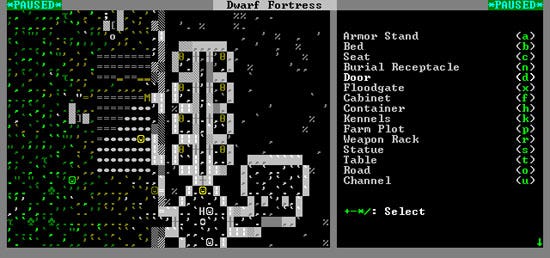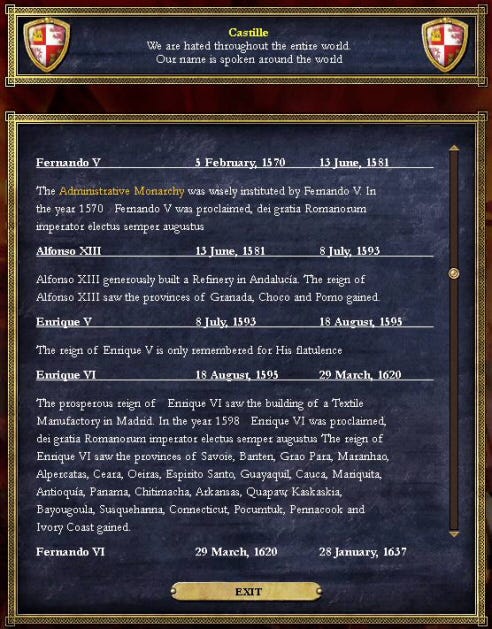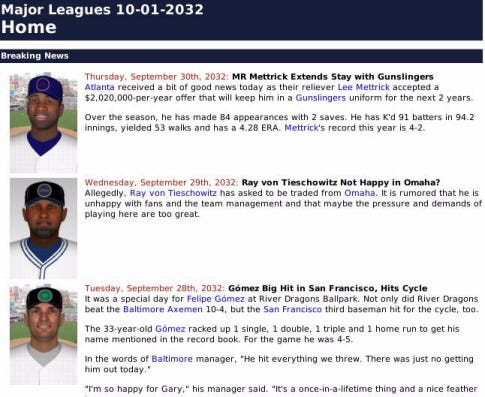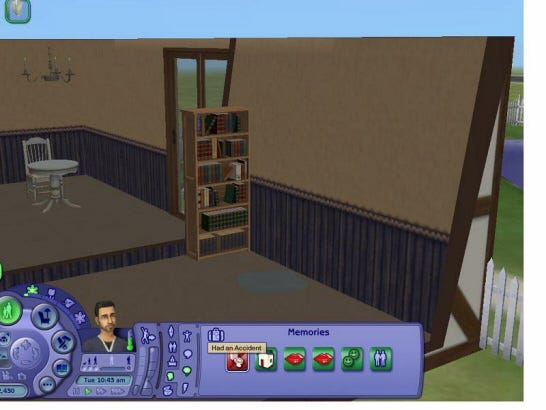Trending
Opinion: How will Project 2025 impact game developers?
The Heritage Foundation's manifesto for the possible next administration could do great harm to many, including large portions of the game development community.
In this in-depth design article, veteran game designer Sorens examines the 'sandbox game' genre, advocating - with plenty of practical examples - that "designers can and should do more to exploit... player-generated stories".

[In this in-depth design article, veteran game designer Sorens examines the 'sandbox game' genre, advocating - with plenty of practical examples - that "designers can and should do more to exploit... player-generated stories".]
We know that every time someone plays a sandbox game, that person creates an original story. When a player creates a family in The Sims, the resulting game -- based on input from the player -- tells the life stories of the members of that family.
When a player takes control of a country in Europa Universalis 3, the ensuing game tells the history of the world during the game's time period. When a player constructs an outpost in (the pictured below) Slaves to Armok II: Dwarf Fortress, the gameplay creates a chronicle of the outpost and its inhabitants.
Though the same could be said of other types of games, my focus will be only on sandbox games because they provide the best canvas for illustration of the main point I want to make: namely, that designers can and should do more to exploit these player-generated stories.
What makes the stories in sandbox games special is that unlike the stories found in other types of games, these are not told primarily by the game's developer. Instead, they are created and directed largely by the player's decisions.
The large number of decision points and wide range of possible outcomes in a sandbox game, usually augmented with randomization by various game systems, make the variation in experiences from game to game and from player to player -- one of the key selling points of sandbox games -- both highly personalized and effectively limitless.

Naturally, the developer must provide some amount of structure, as well as the tools the player uses to shape the story. There must be boundaries, goals, and games system that provide decision points. However, the degree to which the player personalizes the course of the game -- and therefore, the story -- is, by the nature of a sandbox game, immense.
The problem that sandbox games have is that their stories are not obvious. The average player, when asked about the story in a sandbox game, would probably reply, "There isn't one." Since we know this to be untrue, the disconnection between player and story must be an issue of presentation. Players do not realize they are creating a story because the game does not communicate the story in a way they understand.
Since most of us work with modest, zero-sum budgets, where any new features or improvements mean sacrifices in other areas, it is important to design for maximum returns on invested time and money. Story-related features can often fit the bill.
Generally speaking, stories have mainstream appeal across many forms of entertainment. Although numerous games without any story are quite appealing, a compelling story can draw in potential customers whom gameplay alone would not persuade.
The potential appeal of the "story" aspect of player-customized experiences is threefold:
The act of "writing" the story; the feeling that you are playing out a story of your own making. The idea that actions and their consequences become a part of history boosts the enjoyment players find in taking those actions by altering their perspective. It helps in selling the illusion that the game world is real and tangible, rather than a mechanical, mathematical construct.
Enjoying the finished product once the game concludes (or even the "story up to now" while the game is in progress). Once players stop playing, they can savor their creation from a "bird's-eye" perspective, instead of focusing more on the minute-to-minute series of decisions and events that comprise the gameplay.
Sharing a unique experience with others (and enjoying those of other players). A great deal of the fun of sandbox games is reading about the disparate experiences other players have had: their clever plans, their amusing anecdotes, their tales of weal and woe. Incidentally, this sharing not only makes the game more enjoyable for those playing it, it also encourages others to try the game.
Although many games have taken small, tentative steps in exploiting this potential, all mainstream sandbox games have much room for improvement. Examples of these small steps include Europa Universalis III's retirement screen, which sums up the reign of each monarch, Civilization IV's post-game replay showing the changes in empires' borders over time, and quest journals in various RPGs.

A few players take it upon themselves to fill in where the game fails to take advantage, writing their own stories based on their game experiences. For example, players often post "After-Action Reports" (AARs) on strategy game forums. Player-written stories based on the Sims franchise can be found at EA's Sims Exchange, and to its credit, the Sims line offers several other tools to help diligent players organize their experiences into something cohesive, such as a scrapbook and memory collection.
However, to allow the average player, not just the creative and motivated few, to fully enjoy the story-creating potential that sandbox games provide, these games should incorporate features that do the bulk of the grunt work of turning gameplay into story. If the game relies on its player base to be creative and diligent enough to do most of the work themselves, it simply will not happen on a large scale. The typical player of a mass-market game does not want to spend a great deal of effort distilling their experience into a story, and to blunt, most of them are unable to do so even if they tried.

1. Present data and events in narrative form
It is much easier to enable players to think of their experience as a story when data are presented to them as such. Behind a set of important data, there is often a story to tell.
For example, a line graph in Civilization IV showing military strength of all known empires over time, though ideal for helping the player make certain decisions, does not impart on its own the same sense of history that a royal advisor's analysis would:
"O great and bloodthirsty one, now that we have crushed our ancient enemy, the Carthaginians, in the Thousand Year War (2200 BC - 1240BC), our military is unrivaled in the known world! Perhaps our invincible Berserkers should be loosed next against the mewling Zulu in response to their arrogant demands for our gold."
The holy grail of game data-to-story conversion would be one-button story generation. Just push a button, and you get to read the story of your game. For an RPG, it might be in diary form, while the story for a strategy game might take the guise of a history book. It would take a non-trivial amount of work -- likely a full-time professional writer and at least part of one programmer -- to accomplish, but worthwhile features are rarely free.

2. Present analysis of cause, effect, and possible future consequences.
In many cases, the player is not even aware of the link between an event or situation and the decisions, actions, or preceding events that caused it. Linking these things together forms the basic building blocks of a narrative. Events that have been assembled and connected into a cohesive narrative are much more captivating than those same events standing on their own.
For example, SimCity may tell a player that they are out of funds. But how did that happen? Did the player splurge on an airport without enough reserve funds to cover a budget deficit? Did the city borrow so much that it could no longer keep up with interest payments?
Did a series of disasters drive out residents and cause tax revenues to dry up? And more importantly for the player, now what happens? The game could generate a 1-2 paragraph newspaper editorial answering these questions, such as:
"For the second time in six years, the city is bankrupt. Despite record-high taxes of 14%, the mayor has squandered the entire year's budget in less than eight months. We have to wonder whether the recently completed, publicly funded Cowbell Stadium was really necessary, especially when polls show that traffic and crime are the citizens' priorities. No doubt citizens of this experiment in absolute authoritarian government are packing up in droves and moving across the river to Liberty City."
3. Focus the player's attention on the "cool stuff"
That is, make sure the player sees the humorous, unusual, or otherwise noteworthy situations, chains of events, and accomplishments that emerge in any good sandbox game. Showcasing these story-enhancing moments ensures that the player's story contains the juicy details that make it engaging and distinctive.
The game's recognition also lends weight to the player's sense that something cool did indeed happen. A simple example is the Xbox 360's Achievement system, which recognizes significant accomplishments.
Most games already to this to some degree. For example, many sandbox games use the "pause and pan" method to call attention to special events, such as the natural disasters in SimCity.
Another example is the automatic replay found in sports games, where the game detects through a simple trigger (event, animation, time window, etc.) that a spectacular or close play has occurred and queues the instant replay to ensure that the player had a good look at it. These systems are a step in the right direction, but they are generally simplistic and do not cover a wide enough range of situations.
The complexity and open-endedness of the typical sandbox game means that designers must be creative and cover wider ground in detecting these noteworthy situations. For example, in the game Hearts of Iron 2, a player with the handle "Comrade Brian" infamously lost a fleet of Soviet transports to the Tibetan Navy, quite an unusual circumstance given that Tibet was both landlocked and militarily inadequate.
Because the game did not recognize and draw attention to this event, it might have gone unnoticed and unappreciated. Instead, it became something of a legendary event in the Hearts of Iron 2 community because the player recognized and shared it -- something that would happen far more often if the game could perform those tasks on its own.

4. Use goals to provide dramatic structure
The Sims 2, mentioned above as an example of a game that has made some progress in the area of story creation, is also notable for another positive trend in sandbox games: an assortment of concrete goals (Aspirations) to achieve. These goals, which are noticeably absent or unstated/unrecognized in many older sandbox games such as the original The Sims and SimCity, are beneficial for multiple reasons, as intuition or any basic game design book will tell you.
Of particular value in the discussion of story formation is the application of goals to the formation of dramatic structure. If designed with this structure in mind, goals can form the pillars of a sandbox game's dynamically generated stories: incitement, rising action, climax, falling action, and denouement.
I will use the game Slaves to Armok II: Dwarf Fortress to illustrate how a game objective can provide or highlight the skeleton for a story and allow the gameplay to flesh it out. When the player is preparing to launch an expedition to build a new fortress, the game could give the player the stated objective: "Survive the first winter."
The dwarven expedition arrives at the fortress site with nothing but the provisions, equipment, and tools in their cart. How the player accumulates the food necessary to survive the winter can be accomplished through many different means: farming, fishing, brewing, breeding animals and slaughtering them, hunting wild game, foraging, and trading. Along the way, many setbacks can occur: dwarves injured, slain, or otherwise incapacitated, poor management decisions by the player, invasions of hostile creatures, and so on.
These game events can provide the rising action and even the climax for the story of the fortress' first year. The climax could be a goblin invasion that kills off the only skilled fisher-dwarves in the fortress, leaving it too short-handed to accumulate the necessary food before the river freezes over. It could be the completion of a complex irrigation system that allows the dwarves to sow a large farm and reap a bountiful harvest before winter sets in. It could even be something as odd as a dwarf going mad and slaughtering his compatriots.
The falling action and denouement would finish the story of the first year at the fortress. Perhaps the starving dwarves slowly die off, one by one, leaving the fortress to the ghosts. Perhaps the dwarves dine on meat and ale all winter, or perhaps the goblins return and overwhelm the fortress' weakened defenses.
Objectives must be designed to be story-worthy, as well. "Collect (or kill) 100 foozles," with no apparent purpose or connection to anything else in the game, does not lend itself particularly well to a story. However, "Collect 100 Philistine foreskins in order to marry the King's daughter" could be more intriguing.
5. Give characters human qualities
It is easier to see the game's events as a story when the player has emotional ties to those events. There are many methods of increasing this feeling of attachment.
Since this subject has been discussed to death elsewhere, I am only going to mention one relevant aspect of sandbox games that generally needs improvement: giving the game's actors human qualities and making them distinct from one another. Obviously, the Sims series gets a pass, as its entire premise is that its characters behave like real people.
Robotic and soulless characters disconnect us emotionally from the game and cause us to focus on abstract constructs instead. For example, an encounter with a typical MMO enemy, the epitome of soulless and robotic video game characters, does not even register on the emotional scale, and our thoughts during this encounter focus solely on the gameplay-related characteristics of this enemy -- hit point and experience levels, ability timers, etc. -- instead of caring what part this character plays in a story.
Representing the player with a concrete presence in the game can be especially helpful. Many sandbox games limit the player's in-game persona to some nebulous immortal who issues edicts from on high (hence the term "god game"). When there is a human-like entity representing the player in the game, there is a much greater opportunity to establish an emotional connection.
For example, in the Total War series, the player is represented by the faction leader, a distinct, mortal character with human qualities. If the faction leader charges into battle and his bodyguard is crushed, the player may experience fear on behalf of the faction leader, ordering a retreat before he falls in battle.
When the player chooses to slaughter prisoners after a battle, the faction leader's reputation and traits are altered in accordance with the player's actions, increasing the player's feeling that his decisions and his avatar's character are entwined. When the faction leader dies, the player may feel a twinge of regret, even if the new faction leader has better gameplay-affecting attributes.
Contrast this system with the one in the Civilization series, where the player is represented by an immortal, abstract avatar with no in-game presence other than a title, a name, and two generic personality traits. Even the personality traits are abstract and un-human; they have no effect on the game beyond the pre-ordained mathematical benefits. The citizens of the cities are no help, either; their humanity is a flimsy façade that does next to nothing to cover their true identity: One Unit of Productiveness.
As a result, the player has no emotional concern for his ethereal pseudo-avatar or citizens. If citizens are miserable and starving to death, even a player with an empathetic personality will be concerned only with the lost productivity that results, not about the citizens themselves.
Examples of features in existing games that help to give characters personality include
Individual citizens in the Caesar and SimCity franchises sharing their thoughts
Villagers in the Black & White series showing emotion in reaction to events (player, pet, and enemy actions)
Personality profiles and emotional states for individual dwarves in Slaves to Armok II: Dwarf Fortress
Models and animation (especially facial expressions) for opposing rulers in Civilization IV
There are doubtless many other methods to explore; my goal is not to make a comprehensive list, but to promote the untapped "big picture" potential of player-created stories, especially in a type of game whose perceived lack of story reduces the size of its prospective audience.
Read more about:
FeaturesYou May Also Like